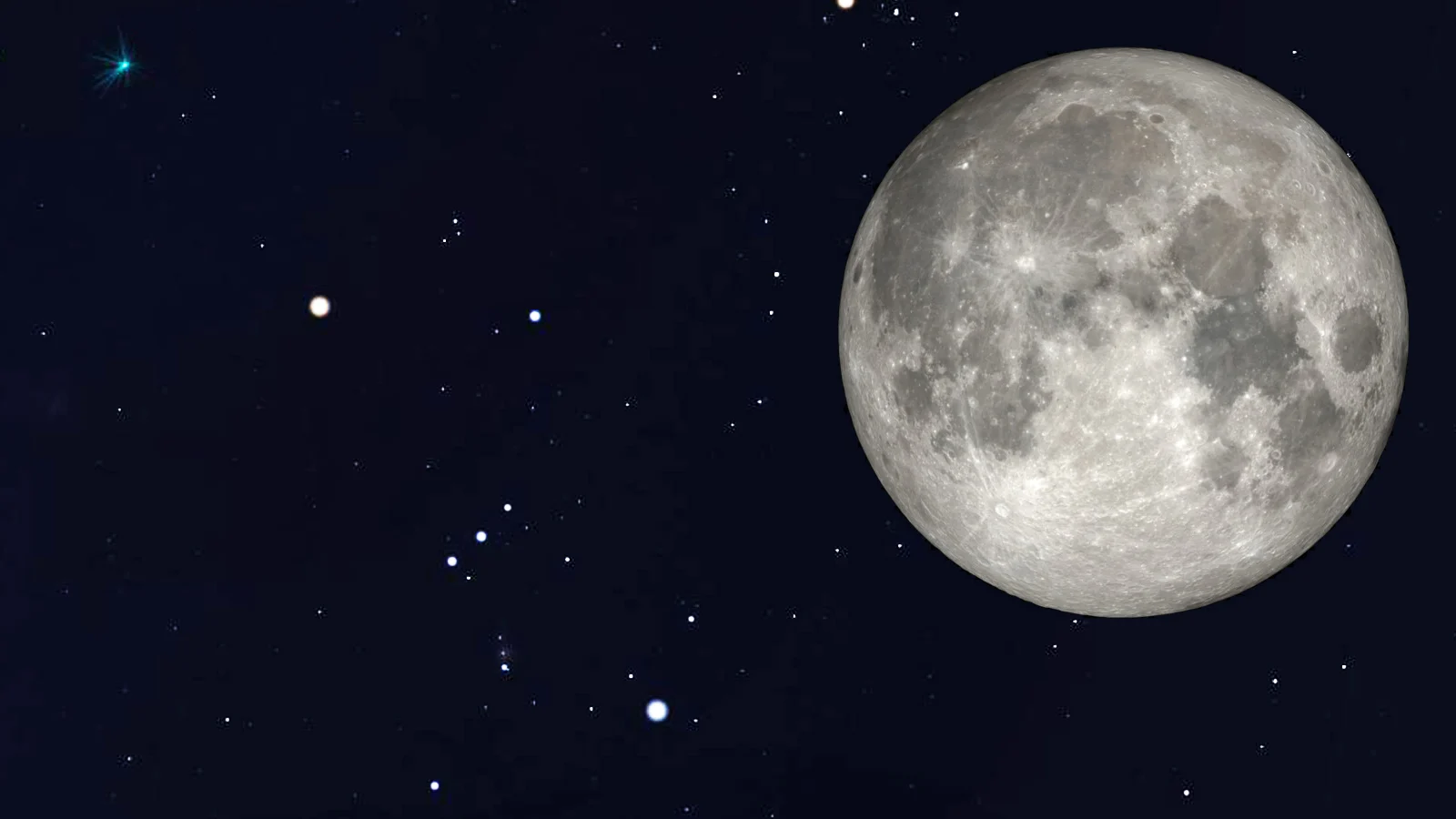
Look up tonight! Orionid meteors are set to flash past the Hunter's Moon
Eyes to the sky! The first Full Moon of Fall 2021 coincides with the peak of the Orionid meteor shower.
As the Sun sets tonight, turn your gaze to the east to see the rising of 2021's Full Hunter's Moon. Stay up a bit later, and you may catch pieces of Halley's Comet blazing through the atmosphere!
Check your weather forecast to see if you'll have clear skies. There's a Full Moon rising, and it won't be completely alone. There are three bright planets sharing the sky, and we have a chance to see the peak of the annual Orionid meteor shower as well.
Visit our Complete Guide to Fall 2021 for an in-depth look at the Fall Forecast, tips to plan for it and much more!
WHAT IS A HUNTER'S MOON?
Each Full Moon of the year has a specific popular name assigned to it. These names were taken from indigenous, colonial American, and old-world folklore.
The September 20 Full Moon, being the closest to the Fall equinox, was the Harvest Moon. The Full Moon that follows the Harvest Moon — which rises on the night of Wednesday, October 20, this year — is known as the Hunter's Moon.
According to NASA, "The earliest use of the term 'Hunter's Moon' cited in the Oxford English Dictionary is from 1710."
The Old Farmer's Almanac says: "It is believed that this full Moon came to be called the Full Hunter's Moon because it signalled the time to go hunting in preparation for the cold winter ahead."
From indigenous folklore, many first nations people had other names for this Full Moon. The Sioux and Comanche peoples named it due to the changing of the season, either directly calling it the "Changing Seasons Moon" or the "Fall Moon". For some, such as the Cherokee and Apache peoples, this was the time to harvest or bring in corn from the fields. The Abenaki, Arapaho, Chippewa, Lakota, and Ojibwe people all named it in reference to the leaves falling from the trees. Others, such as the Cheyanne, Algonquin, and Potawatomi, named it for the first frosts or snow seen at this time of year. Finally, the Cree named it for the birds beginning their southward migration.
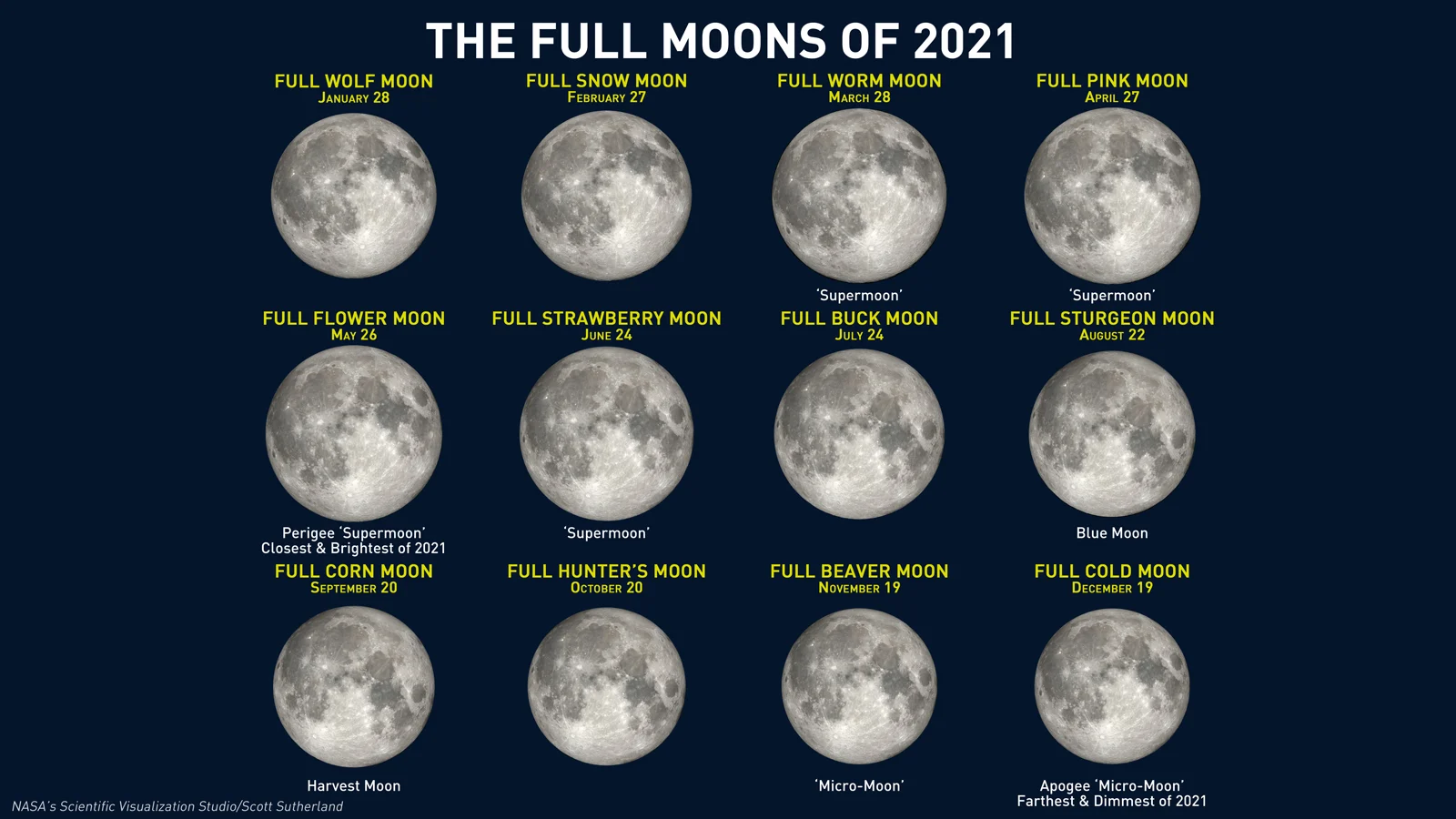
This graphic collects all the relevant data about each Full Moon of 2021, including their popular names, whether they are a 'super' or 'micro' Moon, a perigee or apogee Full Moon, and whether they are remarkable in some other way (Blue Moon or Harvest Moon). Credit: NASA's Scientific Visualization Studio/Scott Sutherland
Not alone in the sky
This Full Moon will not be alone as it crosses the night sky.
As the Hunter's Moon rises on Wednesday, turn around and look to the southwest. There will be a very bright 'star' near the horizon there. That 'star' is actually the next closest planet to the Sun from us, Venus.
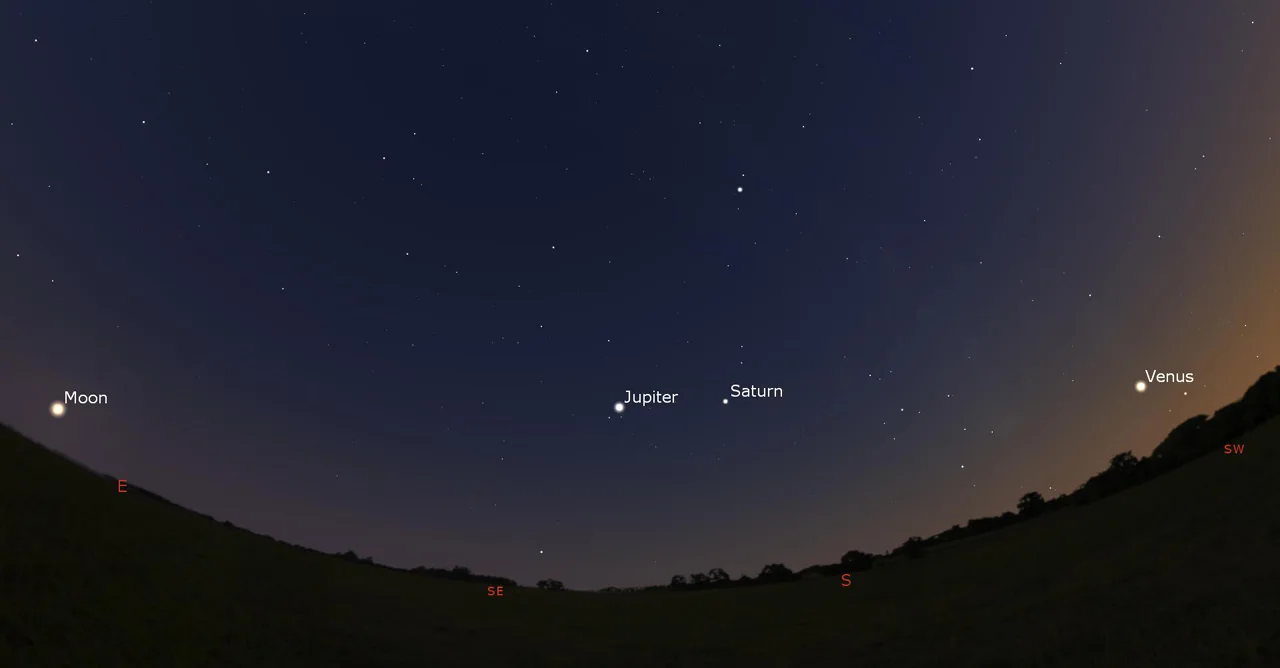
The view of the night sky, after twilight on the night of Wednesday, October 20, 2021. Credit: Stellarium
Turn back towards the southeast, and depending on how much twilight there is, you may pick out two other 'stars' there. The brighter one on the left is Jupiter, and the dimmer one on the right is Saturn.
Also, the night of October 20-21 is the peak of the annual Orionid Meteor Shower.
Orionid meteors can be seen on any clear night from October 2 to November 7. They originate from tiny pieces of ice and dust blown off Comet 1P/Halley hitting the top of Earth's atmosphere. In fact, this is the second of two annual meteor showers that Halley's Comet produces in our skies (the other is the April eta Aquariids).
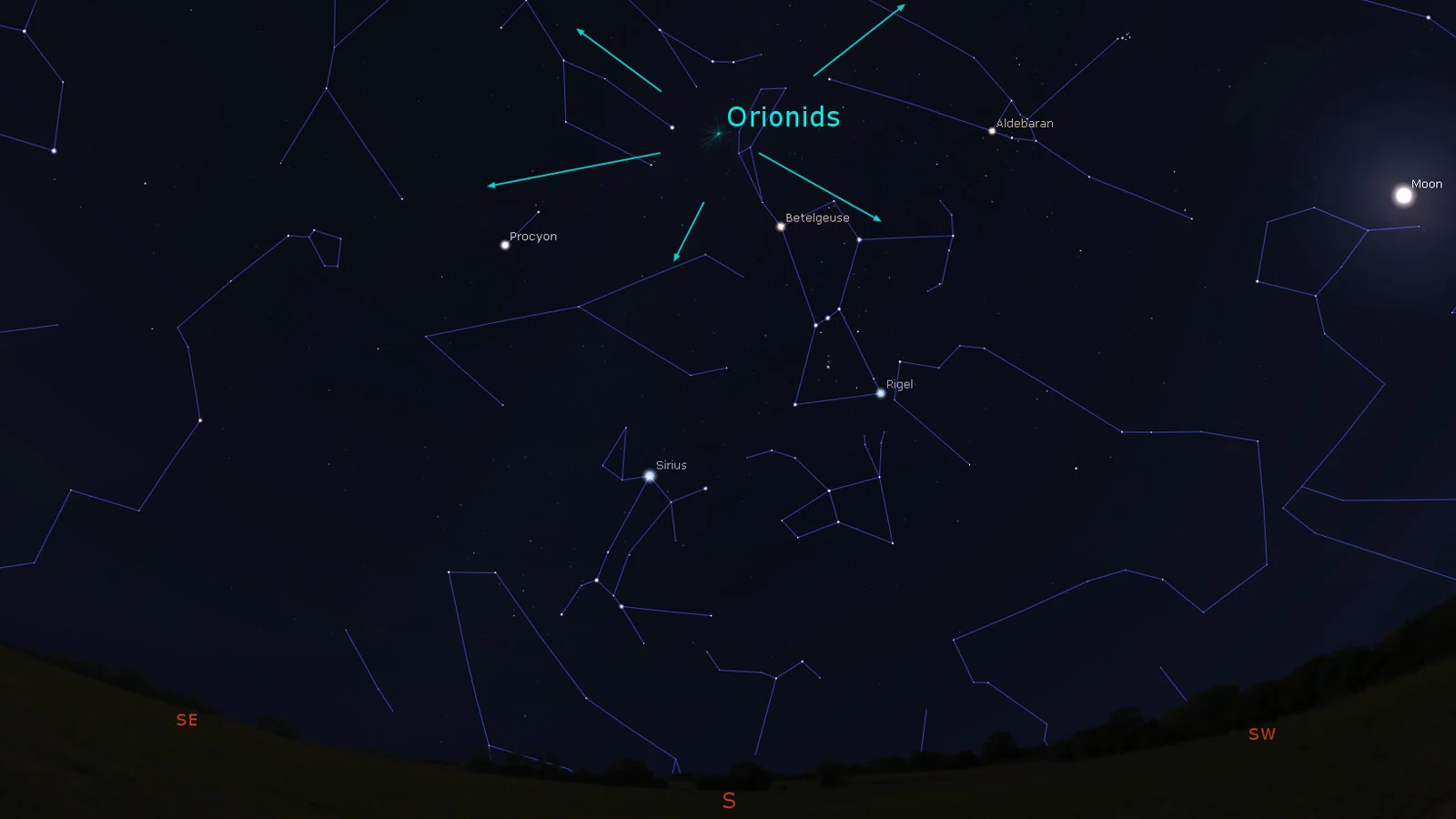
The radiant of the Orionid meteor shower, positioned near the zenith on the night of October 20. Credit: Stellarium
On Wednesday night, Earth will pass through the densest part of the debris stream from Halley's Comet, which will result in the peak of the meteor shower. Orionid meteors tend to be bright, and there's typically up to 20 per hour seen during the peak of the shower.
The general timing of the Orionids' peak is a little unfortunate, though. The light of a Full Moon tends to wash out dimmer meteors. So, we'll see fewer meteors than is typical, this year, but they will definitely be the brighter ones.
According to Spaceweather.com, "Interference from the Hunter's Moon will reduce visible meteor rates from the usual 20 to only 5 Orionids per hour."
However, the general brightness of Orionid meteors, as well as the exact timing, may save the show from being a complete wash!
According to the Royal Astronomical Society of Canada's Observer's Handbook for 2021, the exact peak of the meteor shower is expected early in the morning on Thursday the 21st. With the meteor shower's radiant rising at around 10:30 p.m. local time, it will be about four hours behind the Moon as it tracks across the sky. Therefore, it will still be reasonably high in the sky (the best time to watch a meteor shower) when the Moon is closer to the western horizon, before sunrise.
So, this may be the best time to set your alarms extra early for Thursday and get out in the cool pre-dawn air to catch a few meteors streaking across the sky.
2022's most 'average' Full Moon
As the Moon orbits the Earth, it does not trace out a perfect circle. Instead, its path forms an ellipse. So, for roughly half of the month, the Moon is closer to Earth, and for the rest of the month, it is farther away.
Throughout the year, this produces a pattern where each month, the Full Moon occurs closer and closer to Earth until we have what's known as the year's Perigee Moon. Then, each Full Moon occurs farther and farther until we have the year's Apogee Moon. This pattern changes year by year, as well.
In January, we were already part-way through the cycle of Full Moons getting closer, which began after the October 31 Halloween Micro Blue Moon. So, on the night of the January 28 Full Moon, it was just over 381,000 km away. Then the Full Moons drew closer over the next four months until the May 26 Perigee Moon occurred at 357,463 km away (making it a supermoon). Since then, the Full Moons have been getting farther away.
The October 20th Full Moon will be the farthest of the year so far, at nearly 400,000 km away.
The Full Moons in November and December will be even farther away — 405,000 km and 406,000 km, respectively — after which the cycle starts all over again.
RARE LUNAR ECLIPSE COMING UP!
After Wednesday's Full Moon, we're just one lunar month away from November's rare almost-total lunar eclipse!
On the night of November 18-19, the Full Moon will pass through Earth's shadow. This will result in a partial lunar eclipse — where the Moon only partly dips into the dusky red umbra of Earth's shadow.
What's particularly remarkable about this eclipse is that it's one of the rarest. At its peak, which occurs at just after 4 a.m. EDT on the 19th, the Moon will just barely miss out on being a total lunar eclipse. Instead, just over 2 per cent of the Moon — in a thin sliver near the south pole — will remain in the penumbra.
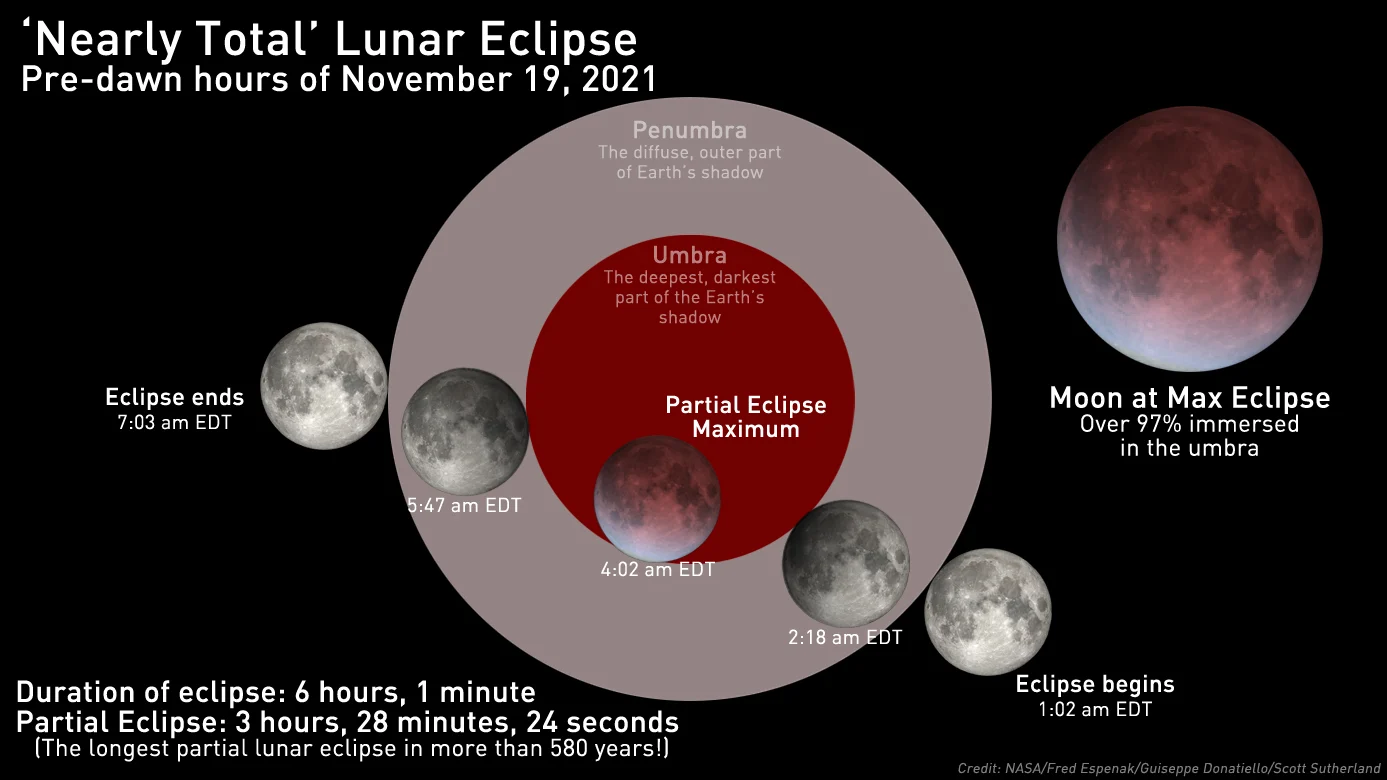
This graphic shows the path of the Full Moon through Earth's shadow in the predawn hours of November 19, 2021. Credit: NASA GSVS/Scott Sutherland
According to NASA's records, the partial phase of this eclipse will last a total of 208.4 minutes, or 3 hours, 28 minutes, and 24 seconds. That makes it one of the longest partial lunar eclipses ever seen!
Before this, the longest 'nearly total' lunar eclipse was over 581 years ago, on February 18, 1440, when there was a partial lunar eclipse that spent 3 hours, 28 minutes, and 48 seconds in the umbra. The next longer partial eclipse occurs — where the Moon will spend an even 3 hours and 30 minutes in the umbra without actually producing a total eclipse — will be nearly 648 years from now, on February 8, 2669!
THE MADDENING MOON ILLUSION
Seeing the Full Moon at any time of night is a spectacular sight. However, go out just after moonrise or just before moonset, and you may catch an exceptional treat. It's not something the Moon itself is doing, though. Instead, it's due to a trick of our mind known as The Moon Illusion.
There are times when the Moon actually does look bigger to us, such as during a supermoon, when the Moon is physically thousands of kilometres closer to Earth than usual. There are other times, however, when we just think it looks larger.
As our eyes take in the world around us, our brain knows from experience that objects close to us tend to appear larger and in focus. In contrast, distant objects tend to be tiny and blurry. From this, it also knows that for a distant object to appear in focus, it must be very large.

This close-up of the Harvest Moon was snapped in Calgary, AB, on September 13, 2019. Credit: Siv Heang
So, when we see a bright Full Moon hanging crisp and clear in the sky above the horizon, it is contrasted by all of the objects on the ground, which appear smaller and blurrier the closer they are to the horizon. This combination confuses the brain. To compensate, the brain interprets the Full Moon as being much bigger than it truly is. To be clear, the Moon is certainly much larger than any of the objects on the horizon (it's 3,474 km across), but this 'illusion' gives us the impression that the Moon looks enormous!
Look up into the sky closer to the middle of the night, and the Moon will be high above our heads. Usually, it will be the only thing we see, other than the stars and maybe a few planets. At that time, the brain is focused only on the Moon, and without the other objects in the field of view to complicate matters, it is free to just 'see' its actual size.
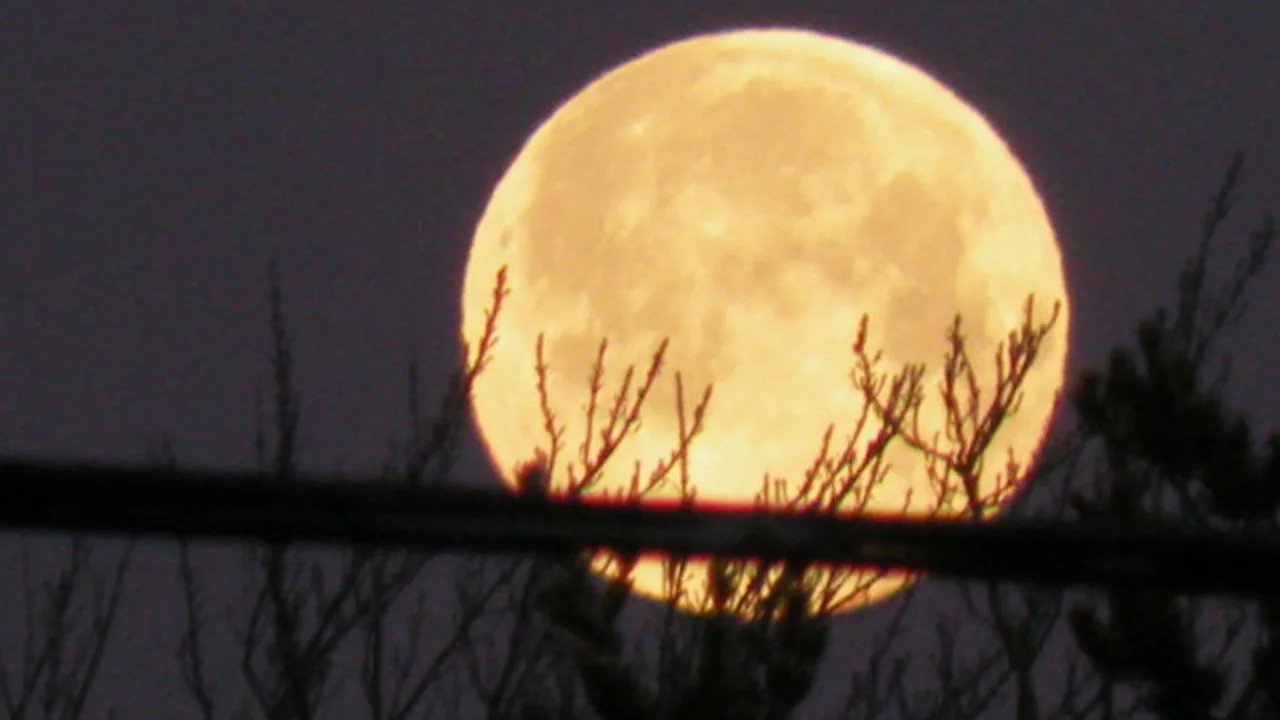
This zoomed-in image of the Full Snow Moon was captured from Salisbury, NB, on February 9, 2020, and uploaded into the Weather Network's UGC gallery. Credit: Darlene MacLeod/Smith
We have a few tricks of our own that can cancel out the Moon illusion, though.
For the first one, we don't need technology. Just go outside after sunset and find the Moon near the horizon. Stretch your arm out towards it, and cover the Moon over with your thumb or even your pinky finger. Note how big the Moon looks compared to the digit in question, and keep that in mind. Maybe even take a picture of it, if you want. Later in the night, check out the Moon again when it is high in the sky. It may appear smaller than when you saw it earlier, but repeat the step to cover it over with your thumb or finger. Compare it with what you saw before, and you'll find that the Moon is actually precisely the same size at both times.
There is a way technology can help us, though. When the Moon is low on the horizon, take out your cellphone, turn your camera on, and point it at the Moon. Note: it is possible for the Moon illusion to still work on us when looking at a picture or video. This is because the brain will make the same judgments of distance, blurriness, and size it did when looking at a 'live' scene. Still, directly comparing what we see in the sky at that time to what is shown on our small cellphone screen can help put things into better perspective. Plus, you can also take a few pictures to upload into the Weather Network UGC Gallery while you're at it!
The thumbnail image for this article combines a view of the night sky from the free open source planetarium software, Stellarium, and a composite image of the October 20 Full Moon, compiled by NASA's Scientific Visualization Studio from data collected by the Lunar Reconnaissance Orbiter.
